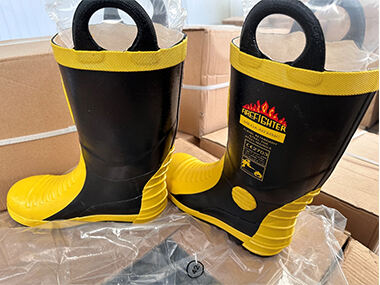As an important firefighting equipment, the design and development of firefighters' rubber boots have gone through multiple stages, from the initial simple protective tools to today's highly specialized equipment. The following is a general outline of the development of firefighters' rubber boots.
1. Early stage (early 20th century)
In the early days, the materials of firefighters' boots were mainly leather and other ordinary durable materials. Although they provided certain protection, they did not have particularly strong performance in terms of waterproofing and high temperature resistance.
2. Application of rubber materials (mid-20th century)
With the widespread use of rubber materials, firefighters' boots began to be made of rubber, especially in terms of waterproofing. Although rubber boots of this period were more practical, they still had certain limitations, such as heavy weight and poor comfort.
3. Technological innovation and improvement of boot structure (1960s-1980s)
As the working environment of firefighters continued to change, the design of firefighting boots gradually improved, and rubber boots began to incorporate more technological elements. For example, the soles of the boots are made of a special rubber formula that is resistant to high temperatures and non-slip, which enhances the protection against high temperatures, chemicals and other dangerous environments. The internal structure of the boots has also been improved to make them more comfortable, breathable, and have better support.
4. Modernization and improved functionality (early 21st century to present)
In recent years, the design of firefighters' rubber boots has become more specialized and multifunctional. For example, many modern fire boots use lighter and more durable composite materials, such as high-performance thermoplastic rubber (TPR) and polyurethane (PU), which provide better comfort, flexibility and durability.
In terms of protective performance, modern rubber boots generally have the following characteristics:
● High temperature resistance Able to withstand extremely high temperatures to avoid melting or burning.
● Waterproof Effectively prevent water, oil, and chemical penetration.
● Slip resistance The design of the boot sole pays more attention to slip resistance, helping firefighters to walk steadily in slippery environments.
● Comfort The lining uses moisture-absorbing and breathable materials to reduce fatigue after long-term wear.
5. Summary
In general, the continuous development and innovation of firefighters' rubber boots has not only improved the work efficiency and safety of firefighters, but also reduced the occurrence of occupational diseases and injuries to a certain extent. As technology advances, the materials and designs of firefighter boots will be further innovated.


 EN
EN
 AR
AR
 HI
HI
 JA
JA
 KO
KO
 NO
NO
 RU
RU
 CA
CA
 TL
TL
 IW
IW
 ID
ID
 SR
SR
 UK
UK
 VI
VI
 SQ
SQ
 GL
GL
 MT
MT
 TH
TH
 TR
TR
 FA
FA
 AF
AF
 MS
MS
 SW
SW
 CY
CY
 IS
IS
 MK
MK
 HY
HY
 AZ
AZ
 EU
EU
 KA
KA
 HT
HT
 UR
UR
 BN
BN
 LA
LA
 MN
MN
 NE
NE
 SO
SO
 MY
MY
 KK
KK
 UZ
UZ



